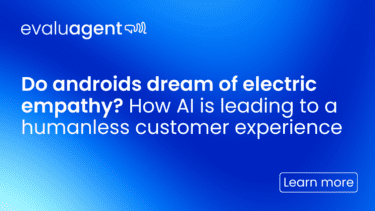Do androids dream of electric empathy? How AI is leading to a humanless customer experience


It’s 8 years since Alice & Bob, two Facebook AIs, had their famous conversation on Meta’s (Facebook’s) digital channels. The result was a trip to say the least. Facebook shut them down and we all had a giggle at the quaint absurdity of robots conversing with robots.
Fast forward to 2025 and there’s nothing quaint about it.
Working at the intersection of artificial intelligence and customer experience, the march from chatbot to conversational AI to voice AI has been breakneck. Once-dumb bots which sold new cars for $1 have been replaced with Voice AI so good, humans can no longer tell the difference. In 2025, we’re all building contact centres to pass a Turing Test, gearing up to provide human-like service to our human customers.
The catch? The customers won’t be human for long.
Just as Voice AI can now fool customers, outbound voice agents can now fool contact centre agents. Today I was able to build an outbound agent which booked me a GP callback. With no code. (Shout out to SynthFlow). And it won’t be long before someone cracks this functionality for retail users.
So where does that leave us? With two AIs, both built to fool humans, talking to one another. Just like Alice and Bob.
This age of digital acceleration is leading to ‘humanless customer experience’, where a customer’s AI and a company’s AI try to solve problems free from the prying ears of their owners.
Just as with Alice and Bob, this will NOT be pretty. AIs will hallucinate. They’ll failover into silence. They’ll agree to outlandish solutions which please no-one and create a poor service, leading to a decline in customer satisfaction.
And they will do this largely in silence, free from oversight from company employees, such as your customer experience leaders. They will clog phone lines for hours. They’ll also undermine the central premise of the contact centre as we know it; Raw information + human judgement = resolution.
That judgement can come from a human customer or a human agent. But when neither side has it, we need a total rethink.
So what will measure success in a machine-to-machine interaction to avoid the issue where live agents sound robotic and offer a humanless customer service?
Or put another way, do androids dream of electric empathy?
Clearly the world of humanless CX is still in its infancy. But if we want the world promised by technology – which could eliminate the need for human customer service options, rather than a bunch of Alices and Bobs shouting at each other across the digital ether – it’s time to get building.